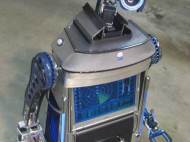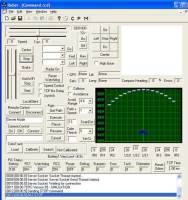Homemade robot Loki is a hobby project of one man
 Most of the robots we wrote about are made by corporations or research laboratories. In this article we’re going to write about a robot made by a single man. Loki, which takes its name from the Norse god of Mischief, is a robot build for hobby. It was made by software engineer David Shinsel, who claims the robot was originally intended to be just remotely controlled, but he got a little carried away.
Most of the robots we wrote about are made by corporations or research laboratories. In this article we’re going to write about a robot made by a single man. Loki, which takes its name from the Norse god of Mischief, is a robot build for hobby. It was made by software engineer David Shinsel, who claims the robot was originally intended to be just remotely controlled, but he got a little carried away.
The “body” of Loki is built completely from scratch, using mostly aluminum. It is 121cm (4′) tall and weights 18kg (40 lbs). The unique design allows a laptop computer to double as the robot brains, and also as a display screen in Loki’s “chest”. Aside the display, the robot resembles a combination of WALL-E and Johnny 5 robots. Head motion and arms are handled by Dynamixel AX12 servos. The shoulder joints are custom chain-drive driven by precisely controlled motors. Its eyes are highlighted with two blue LED lights, programmed to “blink” while the robot operates.
The robot is able to move around by using its wheels while the indoor pathfinding algorithm. Loki has two arms with 3 finger hands, capable of grasping objects. It is able to interact via a remote control and logistics over Wi-Fi, vision processing, speech recognition, and basic artificial intelligence. Loki’s artificial intelligence allows it to operate in two modes. The first mode is “command mode”, where its responses are fairly constrained, and the second mode is “conversation mode”, where you never know what he will say or do.
It is equipped with two webcams (Logitech Notebook Pro webcams) in order to provide the robot with stereo vision. The laptop gets sensor data from a PIC processor, mounted on a Mark III controller board, via a USB to Serial converter. The PIC is programmed using the CCS “C” compiler, and the PC software is written using Visual C++. The PIC I/O is expanded with several I2C chips to provide extra sensor inputs including 2 PIR motion detectors, 10 IR range detectors, 2 Ultrasonic rangers, 4 bumpers, an electronic compass, and motor speed and direction monitors for each wheel.
Loki uses OpenCV for face tracking, SURF object identification, motion detection, color tracking and laser spot tracking. It can also respond to verbal commands with speech synthesis, because it uses Microsoft SAPI 5.1 for speech recognition. In order to get around in its surroundings, Loki uses the A* search method for plotting a course on what appear to be preprogrammed maps. All of this intelligence is handled by an onboard laptop running Windows XP.










larry barnes
628 san julian
l.a.,ca 90014
how much for the robot
This is awesome. Are there plans for this? I would love to attempt to build this. Great Job!!